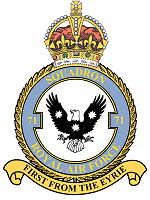No. 71 Squadron RAF
| No. 71 (Eagle) Squadron RAF | |
|---|---|
 | |
| Active | 27 March 1917 – 19 January 1918 19 September 1940 – 29 September 1942 16 September 1950 – 30 April 1957 |
| Country | |
| Allegiance | |
| Branch | |
| Nickname(s) | Eagle |
| Motto(s) | First from the eyries[1] |
| Insignia | |
| Squadron Badge heraldry | A bald-headed eagle displayed charged with three stars of nine points |
| Post 1950 Squadron Roundel |  |
| Squadron Codes | XR (November 1940 – September 1942, also used initially on transfer to USAAF) L (September 1950 – October 1953) |
No. 71 Squadron was a
History
First World War
The first unit known by the British military as "No. 71 Squadron" was No. 4 Squadron, Australian Flying Corps (AFC), during the First World War. The squadron was formed at Point Cook, Victoria, Australia on 16 October 1916, after which it travelled to England. From 27 March 1917, while based at Castle Bromwich, it was designated "No. 71 Squadron" by the Royal Flying Corps, to avoid confusion with No. 4 Squadron, RFC. This name was never officially adopted by the Australian Imperial Force.
4 Sqn AFC arrived in
On 19 January 1918, British usage of "No. 71 Squadron" for this unit also ceased, and it became No. 4 AFC at every level. The squadron spent some time with the Army of Occupation in Germany after the Armistice and was disbanded there at Bickendorf on 28 February 1919.[2]
American Eagles
At the start of the
Into the jet age
On 16 September 1950 a new 71 Squadron was formed at
Aircraft operated
| Dates | Aircraft[6] | Variant | Notes |
|---|---|---|---|
| June 1917 – October 1917 | Various | ||
| October 1917 – January 1918 | Sopwith Camel | 4 Sqn Australian Flying Corps (a.k.a. 71 Sqn RFC) | |
| October 1940 – November 1940 | Brewster Buffalo
|
I | |
| November 1940 – May 1941 | Hawker Hurricane | I | |
| April 1941 – August 1941 | Hawker Hurricane | IIB | |
| August 1941 – September 1941 | Supermarine Spitfire | IIA | |
| September 1941 – September 1942 | Supermarine Spitfire | VB | |
| October 1950 – October 1953 | de Havilland Vampire | FB.5 | |
| October 1953 – May 1956 | North American Sabre
|
F.4 | |
| April 1956 – April 1957 | Hawker Hunter | F.4 |
See also
References
Notes
Bibliography
- Childers, James Saxon. War Eagles: The Story of the Eagle Squadron. Windmill Press, 1943.
- Republished by Eagle Publishing in 1983, ISBN 0-941624-71-4. Same as the 1943 edition, except it has an epilogue of the members in 1982.
- Republished by Eagle Publishing in 1983,
- Halley, James J. The Squadrons of the Royal Air Force & Commonwealth, 1918–1988. Tonbridge, Kent, UK: Air-Britain (Historians) Ltd., 1988. ISBN 0-85130-164-9.
- Rawlings, John D.R. Fighter Squadrons of the R.A.F. and their Aircraft. London: Macdonald an Jane's (Publishers) Ltd., 1978. ISBN 0-354-01028-X.
- Listemann, Phil: N°.71 (Eagle) Squadron 1940-1942 (RAF Fighter Command Squadrons volume 1), ISBN 978-2918590712, 2013.[1]
